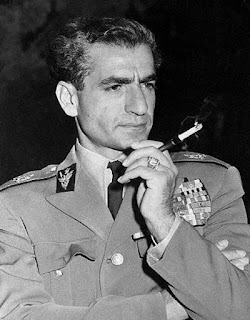THE GUARDIAN: In Tehran, memories of the Shah’s brutality are fading and selling imperial wares is becoming less dangerous. But what’s really behind the increasing fondness for the pre-1979 era?
Near the grand bazaar in Tehran, over the entrance to the complex housing the ministries of foreign affairs and information, the national museum and the Islamic era museum, is a colourful mural, dating to the time of Reza Shah, depicting symbols of Iranian nationalism including a dignified soldier, a Maxim machine-gun, and crossed Iranian flags.
The flags, sporting the distinctive horizontal bands of red, white and green, have been more recently altered than the rest. On all the flags, the white band in the centre has been painted over with a fresh coat of eggshell white. On the green band below you can see, cut off at the ankles, the paws of a lion and on the red band above you can see the rays of a rising sun.
These are remnants, spared a literal-white washing, of the Shir o Khorshid, or Lion and Sun, a coat of arms that graced the Iranian flag from the mid 19th century until the 1979 Revolution when it was replaced by a stylized version of the word Allah (“God”) written in Arabic script.
The Shir o Khorshid, a popular Iranian symbol since at least the 12th century, has since the revolution become associated with the deposed monarch Mohammad Reza Shah Pahlavi and his dynasty. After the revolution, the new government of Ayatollah Ruhollah Khomeini systematically eradicated it from public spaces and government buildings, replacing it with Islamic iconography. Today in Iran nostalgia for the Shah and his government, like the paws of the lion, peeks out from under a coat of white paint.
When I visited the Vakil bazaar in Shiraz or the Jomeh bazaar in Tehran, I saw mountains of Shah-related memorabilia at almost every stall. Vintage Iranian rial notes and postage stamps emblazoned with his face, brass busts of him and his infamously fabulous wife Empress Farah, coffee-table books with full-colour photos of the royal family, countless pendants, rings, and wall hangings depicting the Shir o Khorshid, some vintage and some obviously mass-produced more recently. » | Tehran Bureau correspondent | Wednesday, June 17, 2015
